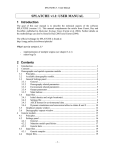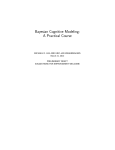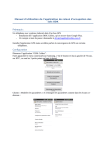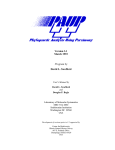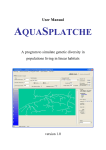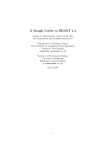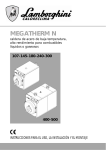Download BATWING USER GUIDE Bayesian Analysis of Trees With Internal
Transcript
BATWING USER GUIDE Bayesian Analysis of Trees With Internal Node Generation. Ian Wilson, David Balding and Mike Weale Correspondence address: Ian Wilson, Department of Mathematical Sciences University of Aberdeen King’s College, Aberdeen, AB24 3UE, UK Email: [email protected] BATWING Home Page: http://www.maths.abdn.ac.uk/˜ijw This guide gives more details of the program described in Wilson, Weale & Balding 2003. Inferences from DNA data: population histories, evolutionary processes and forensic match probabilities. Journal of the Royal Statistical Society: Series A (Statistics in Society), 166: 155-188. COPYRIGHT NOTICE c 2002 by Ian Wilson, David Balding and Mike Weale. Permission is granted to copy this document provided that no fee is charged for it and that this copyright notice is not removed. Guide v1.03, Last Edited: 26 June 2003 Contents 1 Introduction 1.1 General description . . . . . . . . . . . . . . . . . . . . . . . . . . 1.2 Modelling assumptions . . . . . . . . . . . . . . . . . . . . . . . . 1.3 The Bayesian paradigm . . . . . . . . . . . . . . . . . . . . . . . 2 The BATWING software 2.1 Downloading and Installation . . . . . . . . . . 2.1.1 Unpacking on Unix . . . . . . . . . . . . 2.1.2 Unpacking on Windows, and Macintosh 2.2 The Distribution . . . . . . . . . . . . . . . . . 2.3 BATWING command line . . . . . . . . . . . . 2.4 Data settings . . . . . . . . . . . . . . . . . . . 2.5 Population model settings . . . . . . . . . . . . 2.5.1 Population size . . . . . . . . . . . . . . 2.5.2 Population structure . . . . . . . . . . . 2.6 Mutation model settings . . . . . . . . . . . . . 2.6.1 STR (microsatellite) loci . . . . . . . . . 2.6.2 UEP sites . . . . . . . . . . . . . . . . . 2.7 Time scaling and parameterisation options . . . 2.8 Prior distributions . . . . . . . . . . . . . . . . 2.9 MCMC control settings . . . . . . . . . . . . . 2.10 Output . . . . . . . . . . . . . . . . . . . . . . 2.10.1 The newick file format . . . . . . . . . . 2.10.2 Post-processing . . . . . . . . . . . . . . . . . . . . . . . . . . . . . . . . . . . . . . . . . . . . . . . . . . . . . . . . . . . . . . . . . . . . . . . . . . . . . . . . . . . . . . . . . . . . . . . . . . . . . . . . . . . . . . . . . . . . . . . . . . . . . . . . . . . . . . . . . . . . . . . . . . . . . . . . . . . . . . . . . . . . . . . . . . . . . . . . . . . . . . . . . . . . . . . . . . 3 3 4 4 5 5 5 5 5 6 6 7 7 7 7 7 8 9 10 11 14 16 16 3 Data Simulation 16 4 Example session 17 5 Alphabetical listing of infile options 22 2 BATWING MCMC MRCA SMM SNP STR TMRCA UEP Bayesian Analysis of Trees With Internal Node Generation Markov chain Monte Carlo Most recent common ancestor Stepwise mutation model Single nucleotide polymorphism Short tandem repeat (= microsatellite) Time since MRCA Unique event polymorphism Table 1: Acronyms used in the text. 1 1.1 Introduction General description BATWING is a program written in C for the analysis of population genetic data, written by Ian Wilson, now at the University of Aberdeen. Its initial development was in collaboration with David Balding, now at Imperial College, London, and formed part of a research project funded by the UK EPSRC under the Stochastic Modelling in Science and Technology programme. BATWING is described in Wilson, Weale & Balding (JRSS A 166: pp 155-188 ) Please send comments on this User Guide to [email protected]. BATWING reads in multi-locus haplotype data, and model and prior distribution specifications, and uses a Markov chain Monte Carlo (MCMC) method based on coalescent theory to generate approximate random samples from the posterior distributions of parameters such as mutation rates, effective population sizes and growth rates, and times of population splitting events. It also generates approximate posterior samples of the entire genealogical tree underlying the sample, including the tree height, which corresponds to the Time since the Most Recent Common Ancestor (TMRCA). BATWING does not model the effects of either recombination or selection, and hence implicitly assumes that these effects are negligible. Note also that BATWING is intended for within-species data, and not between-species data for which many phylogenetic software packages are available. BATWING is a direct descendant of MICSAT, described in Wilson & Balding (Genetics 150, pp 499-510, 1998). The principal differences are: (1) in addition to the stepwise mutation model (SMM) for microsatellite loci, there are mutation models for unique event polymorphisms (UEP); and (2) the population demography is extended from constant size, random mating, populations (the standard coalescent model), to include population growth and subdivision. A manuscript giving detailed illustrations of BATWING-based analyses, “Inferences from DNA data: population histories, evolutionary processes, and forensic match probabilities”, by Wilson, Weale, and Balding, is currently under review for publication; a preprint is available from any of the authors. 3 1.2 Modelling assumptions Underlying BATWING are various modelling assumptions, many of which are also assumptions underpinning coalescent theory (see e.g. Nordborg 2001). In the case that the data are drawn from a single population, two key assumptions are that the data form a random sample from the population, and that the population is random mating. For structured data, drawn from k subpopulations, BATWING assumes a common, random-mating ancestral population which split into two isolated random-mating subpopulations. If k > 2 then one or both of these subpopulations split again, and so on until k random-mating subpopulations existed at the time of sampling. Three models are available for the population size: (0) constant, (1) pure exponential growth, and (2) exponential growth from a constant ancestral population size. For structured data, the start-of-growth time in model (2) is the same across all subpopulations, and there is also a common growth rate under models (1) and (2). Natural populations are unlikely to satisfy BATWING’s modelling assumptions. In particular, BATWING assumes that population splitting events are instantaneous, with no subsequent migration, whereas in reality splits may be gradual and followed by migration. However, more realistic models will almost certainly have too many parameters for useful inferences to be drawn. We have tried to find a satisfactory compromise between reality and tractability, so that the most important features of the data are exploited to quantify the major underlying demographic events. It must be recognised that some questions of interest about historic demography cannot be answered from present-day genetic data alone. 1.3 The Bayesian paradigm BATWING implements the Bayesian paradigm for statistical inference. Most scientists have been trained in the classical paradigm, which dominated 20th century science. The Bayesian approach is older, having been the predominant mode of inference in the 19th century, but has returned to prominence in recent years, due in large part to the availability of fast computing, and algorithms such as MCMC. A key feature of the Bayesian paradigm is that a probability distribution is associated with all the unknowns. The investigator specifies both a prior distribution, representing knowledge about the unknowns before the present data are taken into account, and a likelihood function which assigns probabilities to the data given values for the unknowns. Bayes Theorem can then be employed to convert the prior distribution and likelihood into a posterior distribution. Information used in formulating the prior may come from previous studies of related systems, theory, and informal judgement. Sometimes scientists choose to downweight or ignore available prior information, and formulate a diffuse prior, giving support to a wide range of values for the unknowns. Although there is not usually a unique prior distribution, and hence not a unique posterior, computational power is now available to explore a range of priors: often the 4 posterior is dominated by the likelihood, so that the posterior distribution is essentially invariant over a wide range of priors. If not, the investigator learns the crucial information that his/her data are only weakly informative about some parameters of interest, and hence background information must be chosen with care and accurately reported in any publication. BATWING offers a range of probability distributions from which investigators can choose priors for mutation rates, effective population sizes and growth rates, and population splitting times (see Section 2.8). For unknowns which are properties of the genealogical tree, such as the TMRCA, BATWING offers several models from coalescent theory, outlined above in Section 1.2 and in more detail below in Section 2.5. Note that we speak of coalescent models, even though they specify priors for the unknown genealogical tree. Although model and prior are usually thought of as distinct, the distinction is not fundamental and is a matter of custom and convenience. 2 The BATWING software 2.1 Downloading and Installation The main distribution, and the only available for unix systems, is in the file batwing.tar.gz, a zipped tar file. The first step is to download this file which is available at http://www.maths.abdn.ac.uk/˜ijw. If you work under Windows or Macintosh (MacOS 8.0 or above) systems, executable files batwing.exe and MacBatwing.hqx are also available at the same site (but batwing.tar.gz is still needed for documentation and other files). 2.1.1 Unpacking on Unix The downloaded file, batwing.tar.gz, is unpacked using these command gunzip -c batwing.tar.gz | tar xf on a command line. To produce the executable file type make (or alternatively on some systems gmake). This should make the batwing, sample and prior programs and put them in the bin subdirectory. 2.1.2 Unpacking on Windows, and Macintosh Under these systems any decompression software, such as winzip should unpack batwing.tar.gz. 2.2 The Distribution The distribution when unpacked will extract the files into a directory batwing with subdirectories bin (executable files), data (data files), examples (example files), doc (documents, including this Guide), sample (files for programs to sample from the model) and src and R (source files). To run the programs from a command line you will need to add the bin directory to your path, or copy the program into the directory with your input files. 5 In this document we use this font to indicate BATWING parameters and filenames, and thisf ont for variable names. File listings use a fixed-width font. The first line of a file listing gives the path to the file in the distribution, to enable readers to find the file in the BATWING distribution. The # symbol is used to denote a comment, which is ignored by BATWING. 2.3 BATWING command line The unix and windows versions of BATWING are command line driven. (although BATWING can be run by double-clicking under a Windows environment). Syntax: batwing infile outfile <seed> The <> notation indicates that seed is optional; infile and outfile are required and will be prompted for if not supplied. infile The input filename; the default infile is assumed if not specified, e.g. if BATWING is run by double-clicking batwing.exe in a Windows environment. Can contain settings for: (1) data file path; (2) models and prior distributions and (3) MCMC control parameters, such as the number of outputs and the number of update steps between outputs. All settings are made via the syntax name: value on a separate line. Default values exist for many settings, see Sections 2.4 to 2.9 and Section 5. outfile The output filename stem; default out. Various output files are created with this stem and different extensions: outfile.par contains a copy of the infile information and information about MCMC acceptance rates; outfile.iit, outfile.end, and outfile.x (where x is an integer) give states of the genealogical tree and other parameters visited by the MCMC algorithm, while outfile (without an extension) gives the parameter values output by the algorithm. See Section 2.10 seed Seed for the random number generator, default value 1. Can also be specified in the infile but a command line seed takes priority. 2.4 Data settings The location of the observed data is specified by a line of the form datafile: <<path/>filename> in the infile. If path/ is omitted the current directory is assumed, otherwise the path should be specified relative to the current directory; default setting is datafile. Data files have one line per haplotype, with one or more spaces separating the alleles at distinct loci. Following #, the remainder of the line is ignored (the whole line is ignored if # is the first non-space character). First come the UEP alleles which may be coded by any two single alphanumeric characters (e.g. “0” and “1”, or “A” and “T”). Next come the microsatellite, or STR (= short tandem repeat), alleles, coded by an integer value giving 6 the number of tandem repeats at that locus (a constant added to each allele length at a locus has no effect on inferences; also, arbitrary numeric allele labels are allowed under the k-alleles model, Section 2.6.1). Missing STR data can be specified using −1. If the data are drawn from several distinct populations (i.e. migmodel=1, see Section 2.5.2) the positive integer label specifying the source subpopulation is stored in a file locationfile, in the same way as for datafile. Rows of the locationfile should correspond to the rows of the datafile. Subpopulation codes may be any positive integers. Missing location information can be specified using −1; if this is used the total number of subpopulations must be assigned to Npopulations in the infile. 2.5 2.5.1 Population model settings Population size The population growth model is specified via sizemodel which can be assigned one of three values (default 0): 0 Constant (effective) population size N (chromosomes); in this case BATWING implements the standard coalescent model. 1 Pure exponential growth at rate alpha to a current population size N . 2 Exponential growth at rate alpha from a constant-size ancestral population of size N , with growth starting at (scaled) time beta before present. 2.5.2 Population structure Two options are available for population structure. Setting migmodel=0 specifies that the data are drawn from a single population (the default). If migmodel=1 then the subpopulation from which a haplotype in datafile is drawn must be specified by a positive integer on the corresponding row of locationfile, with −1 indicating missing data. If there are missing data then Npopulations must be assigned the number of subpopulations. If no data are missing, Npopulations is set automatically to the number of distinct codes used in locationfile. 2.6 2.6.1 Mutation model settings STR (microsatellite) loci The default mutation model is the SMM, under which the repeat number changes by one at each mutation event, with decreases and increases being equally likely. The default prior distribution on the ancestral allele size is uniform on the positive integers. This is an improper prior, but always leads to a proper posterior distribution. Although negative allele lengths are not excluded under our model, positive observed states and a positive ancestral state means that intermediate negative states are extremely unlikely. An alternative is the k-allele mutation model, under which a mutant allele is equally likely to take any one of the k possible states, irrespective of the previous 7 state. To specify this model, kalleles should be assigned a list (separated by spaces) of the numbers of alleles possible at each locus, the loci having the same order as in datafile. Under either SMM or k-alleles model, by default all loci have the same mutation rate; this default can be explicitly set by assigning locustypes the integer 1. If locustypes is assigned an integer equal to the number of STR loci, there is a distinct mutation rate for each locus. The only other setting permitted for locustypes is a list of positive integers whose sum is the number of STR loci. If for example there are 11 STR loci and the list is “3 6 2”, then there are three distinct mutation rates, one common to the first three loci, one shared by the next six loci, and one shared by the final two loci. Clearly, the loci have to be ordered so that loci with the same mutation rate are neighbouring. 2.6.2 UEP sites Unique Event Polymorphism (UEP) sites are polymorphic sites at which only two alleles are observed and the investigator assumes that a single historical mutation event was responsible for the observed polymorphism. These may include insertion/deletion polymorphisms, such as an Alu insertion, or singlenucleotide polymorphisms (SNP). The number of UEP sites should be assigned to infsites (default: 0). There is an ascertainment problem common to many genetic data types but which is often particularly acute for UEP data. Such sites may have been included in a genetic survey because they were known in advance to be polymorphic; possibly they were known to be highly polymorphic in several populations. Inferences which may validly be drawn from a site ascertained in this way may differ substantially from valid inferences had exactly the same data been observed at a site which was chosen “at random”. To allow some investigation of ascertainment effects BATWING allows three ways to incorporate UEP sites into the analysis, selected by setting inftype (default is 0): 0 Conditions on there being a single mutation at each UEP site. Hence UEP positions on the tree contribute to the tree likelihood, and the posterior density, but no inference is drawn about the mutation rate. 1 Assumes the same UEP mutation rate for all UEP loci, with a uniform prior. UEP positions within the tree contribute to the tree likelihood and posterior density. 2 Only trees consistent with the UEP data are permitted, but UEP data are not used in any other way. For insertion/deletion polymorphisms, it may be reasonable to assume that the ancestral state is known. For SNP sites modelled as a UEP, the ancestral state is typically unknown. If the parameter ancestralinf is assigned a UEP haplotype, this is taken to be the haplotype at the root node (i.e. the haplotype 8 of the MRCA at the UEP loci). To use this feature, UEP alleles must be specified in the same way both in the datafile and for ancestralinf. Currently, an ancestral state can be assigned either to all or none of the UEP loci. 2.7 Time scaling and parameterisation options BATWING follows the coalescent theory convention of working with times (such as the TMRCA, or a population split time) expressed in units of N generations. Time 0 corresponds to the present, and large positive times correspond to far back in the past. The value of N used by BATWING for the time scaling is the current effective population size (Nc ) under model 1, but the ancestral effective population size (Na ) under model 2. The reason for this choice is that Na is not defined under model 1, whereas under model 2 it is Na that has the most important effect on the data; Nc is realised only instantaneously. BATWING users can choose to work either with the unscaled growth rate alpha and mutation rate mu, or the scaled growth rate omega = N × alpha and scaled mutation rate theta = 2N × mu (the “2” appears in the definition of theta for historical reasons). A feature of working with scaled rates and times is that the likelihood under BATWING’s modelling assumptions does not depend on N , which may thus be eliminated from any analyses. This reduction in the number of unknowns may lead to more precise inferences about the remaining unknowns. However, if N is unknown then interpretation of the results is severely limited because times and rates cannot be expressed in terms of generations or years. For this reason it is often preferable to work with unscaled rates, together with explicit assignment of prior and posterior distributions to N . A scaled time output by BATWING can then be converted into an unscaled time (in generations) via multiplication by the prevailing value of N (a further multiplication by generation time leads to a time in years). Note, however, that inferences about unscaled parameters usually depend more sensitively on the prior specification than do inferences for the scaled parameters. For example, when the sample size is very large the data may convey substantial information about N × mu so that the posterior for theta may be effectively independent of the prior, but how this information is allocated to N and mu separately may depend sensitively on their joint prior distribution. A further parameterisation option is offered by BATWING under growth model 2, where users can choose to work either with a (scaled or unscaled) growth rate or with kappa (the natural logarithm of current to ancestral population sizes). Since Nc = Na eNa ×alpha×beta , it follows that kappa = Na × alpha × beta = omega × beta. The parameterisation options available within BATWING under the three population size models are summarised in Table 2. An option is selected by assigning a prior distribution to the corresponding parameters (see Section 2.8 9 Population size model 0 1 2 code U S U S U U’ S S’ N * mu * theta Parameter alpha omega kappa beta * * * * * * * * * * * * * * * * * * * * Table 2: Parameterisations available within BATWING under the different models for population size (see Table 3 for brief definitions of the parameters). Users must choose one of the parameterisation options and assign a prior distribution to each of the parameters indicated by a * in the corresponding row. The code U denotes that N is included as a parameter and hence inferences may be obtained for unscaled rates and times; S denotes that only inferences about scaled rates and times are possible. Under model 2, the ’ denotes that kappa is included instead of a growth rate parameter. below). A brief summary of all BATWING parameters that may need to be assigned a prior distribution is given in Table 3. 2.8 Prior distributions The distributions supported by BATWING for univariate parameters are: uniform< (v1, v2) >; uniform on the interval (v1, v2); default interval is (0, ∞), which specifies an improper prior. constant(v1), or just v1. normal(v1,v2); mean = v1; SD = v2. lognormal(v1,v2); if X has this distribution then log(X) has the normal(v1,v2) distribution. gamma(v1,v2); mode = (v1−1)/v2, mean = v1/v2. All the parameters within one of the parameterisation options shown in Table 2 must be assigned a prior distribution from the above list. In addition, in models with population structure, split and prop must also be assigned a prior. The latter is a multivariate parameter, and the only prior distribution available is the dirichlet(v1, v2, . . . , vn). The case v1 = v2 = . . . = vn = 1 gives the (multivariate) uniform distribution. The case v1 = v2 = . . . = vn = 2 is the default prior. When n = 2 the dirichlet is also known as the beta distribution. Prior distributions for scaled genealogical times are assigned implicitly via choice of the demographic model; for example, under model 0 (the standard coalescent) the prior TMRCA when the sample size is two has the exponential 10 Parameter N mu theta alpha omega kappa beta split prop Description and comments Effective population size (haploid); current (Nc ) under model 1, ancestral (Na ) under model 2 Mutation rate; a list of prior distributions is required if locustypes 6= 1 theta = 2N × mu Unscaled growth rate (per generation); only positive values allowed; if migmodel=1, all subpopulations have the same growth rate omega = N × alpha kappa = loge (Nc /Na ) = Na × alpha × beta beta, the time at which population growth starts Time of the first population split Proportion of the total population size taken up by each subpopulation; dirichlet is only permitted prior family and dirichlet(2, 2, . . . , 2) is the default Table 3: Summary of the BATWING parameters that may need assignment of a prior distribution, according to the parameterisation option selected from those given in Table 2. The final two parameters are used whenever migmodel=1. distribution with expectation and SD both equal to 1 coalescent unit; as the sample size gets large, the prior expectation and SD of the TMRCA approach 2 and 1.08 units, respectively. The prior for unscaled genealogical times is assigned implicitly by choice of demographic model and the choice of prior for N ; the prior expectation of the unscaled TMRCA (in generations) of a large sample is approximately twice the prior expectation of N . To assign a prior distribution, append “prior” to the parameter name shown in Table 3, followed by a colon, space, and the distribution, all on one line of the infile. For example, thetaprior: gamma(20,2) assigns a gamma prior to theta. The prior mean is 10 and the prior mode is 9.5. If the ancestral states at the UEP loci are known, then these values can be fixed in the BATWING analyses via ancestralinf. For example, ancestralinf: 00000 assigns 0 to the ancestral state of the five UEP loci. If ancestralinf is not set, the two states at each locus are a priori equally likely. 2.9 MCMC control settings The starting state of the genealogical tree and other parameters may be chosen automatically by BATWING, or a starting tree may be specified in Newick format (see Section 2.10.1) using an initialfile assignment in the infile. The 11 latter option is useful for resuming a BATWING run which has been interrupted either by the user or by a computer failure. initialfile contains complete information on an instance of a tree from a previous MCMC run – such as those output as outfile.iit, outfile.end, or as outfile.x (where x is an integer) – these files consist of information about the tree in Newick format and information about the other parameters and the population tree (if appropriate). New MCMC settings can be specified via the infile as usual. If seed is specified in the infile, it takes precedence over the initialfile settings (and a command line seed takes precedence over an infile setting). All other settings in the infile (e.g. priors) are over-ruled by the settings specified in the initialfile. If the initial tree is not specified, it is generated by BATWING, with the badness parameter controlling the suitability of this tree for the data: 1 specifies a random tree, chosen independently of the data, while 0 specifies a tree obtained via a parsimony heuristic, with each coalescence occurring between between the two nodes with the most similar haplotypes. A value between 0 and 1 allows a mixture between these two extremes. See Wilson & Balding (1998) for more details. BATWING allows warmup to be set in the infile. However, this merely specifies an additional number of outputs to be generated. No portion of a BATWING run is automatically discarded: the user must explicitly choose how many of the initial outputs to discard as burn-in. Therefore, use of warmup is optional, and if used a warning message is generated. One important diagnostic tool for an MCMC run are the plots of the autocorrelation function (ACF) of the output values, both for the parameters of interest and for the log-likelihood. Ideally, the ACFs should be as small as possible. However, it is usually not worthwhile investing in reducing the ACF provided that the values decrease approximately monotonically to zero, and become negligible at lag much less than the square root of the number of outputs. The two BATWING parameters controlling the “thinning” of the BATWING output, and hence the ACF, are Nbetsamp, which gives the number of changes that are made to model parameters between sampling occasions, and treebetN, the number of changes to the tree attempted between changes in the model parameters. We make more changes to the tree than to the model parameters because tree changes are computationally cheap. The appropriate balance between Nbetsamp and treebetN requires experimentation, and depends on the number of loci and the sample size. The effects of varying them are illustrated by the three infile shown at the top of Figure 1. Resulting autocorrelation plots for theta and L, up to lag 30, are shown at the bottom of the figure. Increasing treebetN at the cost of a proportional reduction in Nbetsamp has a slightly deleterious effect on the autocorrelations, while decreasing computation times by about 25%. All the ACF shown in the figure would usually be regarded as acceptable (the number of outputs is the default 1 000). 12 #../examples/thinning/thin1.in datafile: ../../data/examples/ex1.data treebetN: 2 Nbetsamp: 50 #../examples/thinning/thin2.in datafile: ../../data/examples/ex1.data treebetN: 5 Nbetsamp: 20 #../examples/thinning/thin3.in datafile: ../../data/examples/ex1.data treebetN: 10 Nbetsamp: 10 1.0 0.8 ACF 0.2 0.0 0.2 0.0 10 15 20 25 30 0 5 10 15 20 25 30 0 15 20 Series o2$L Series o3$L 25 30 25 30 0.8 ACF 0.2 0.0 0.2 0.0 20 0.4 0.6 0.4 ACF 15 30 0.6 0.8 0.8 0.6 0.4 10 25 1.0 Series o1$L 1.0 Lag 0.2 5 10 Lag 0.0 0 5 Lag 1.0 5 0.4 0.6 0.8 0.4 ACF 0.6 0.8 0.6 0.4 0.0 0.2 ACF 0 ACF Series o3$theta 1.0 Series o2$theta 1.0 Series o1$theta 0 5 Lag 10 15 Lag 13 20 25 30 0 5 10 15 Lag 20 2.10 Output BATWING generates a text file outfile, of which each line after the first contains a space-separated list of floating point or integer numbers giving the values of the unknowns at one instant of the BATWING run. The first line of outfile gives names of the output variables, which we now briefly describe: 1. ll times, the log-likelihood of the coalescent times of all interior nodes in the genealogical tree. 2. (if there are STR loci) ll mut, the log-likelihood of all the STR mutation events that occur between all nodes in the genealogical tree. 3. (if infsites > 0) ll inf, the log-likelihood of all the UEP mutation events that occur between all nodes in the genealogical tree. If inftype is set to 2 in infile, the value 0 is always output (see 2.6.2) 4. ll allpriors, the log-prior probability of the current values of all the model hyperparameters. This column is also a catch-all for all things not covered in the first 3 columns. For example, if population splitting is specified in the infile, then the log-likelihood of all population splitting times is also included here. The sum of the first 4 columns gives the log-posterior probability (up to a constant). 5. the STR mutation rate, either unscaled (mu) or scaled (theta). If separate rates have been specified for different STR loci using locustypes, then they all appear here in separate columns. 6. (if a prior has been assigned) N , the effective population size (Nc if sizemodel=1, Na if sizemodel=2). 7. (if inftype=1) the UEP mutation rate. 8. T , the TMRCA, or time since the most recent common ancestor of the sample, in coalescent units (multiply by N to obtain TMRCA in generations). 9. L, the total branch length of the tree, in coalescent units. 10. (if sizemodel 6= 0) the population growth rate, either unscaled alpha or scaled omega. 11. (if sizemodel=2) beta, the time at which growth starts. 12. (if sizemodel=2) kappa = Na × alpha × beta = omega × beta. 13. (if infsites > 0) the next infsites columns give the binary states of the UEP loci at the root node of the tree (will always equal ancestralinf if set). 14. (if migmodel=1) the next k columns, k= # subpopulations, give the relative subpopulation sizes. 14 15. (if migmodel=1) the next 2(k−2) columns are pairs of numbers for each population merging event, starting with the most recent one and ending with the penultimate one. The first number indicates which clades merge at this point. To interpret this, first convert the number into binary form with k digits in the order corresponding to the locationfile codes (with Pop 1 as the least significant digit and Pop k as the most significant digit); 1s indicate which populations are beneath this node. The second number of the pair gives the time of the merging event. After these k−2 pairs of columns, a final column gives the time of the final coalescence event. 16. (if infsites > 0 and UEPtimes=1) the next infsites×2 columns are pairs of numbers for each UEP locus, giving the descendent and ancestral node times of the branch on which the UEP mutation occurred. 17. (if countcoals=1) the number of coalescences occurring more recently than the start of growth. When BATWING has finished running, it creates an outfile.par text file with details of model settings used in the analysis and acceptance rates for the following Metropolis-Hastings proposals: cutjoin : moving a node to somewhere else in the tree. times : changing the time of a node. haplotype : changing the STR haplotype of a node. splitprop (if migmodel = 1): changing the subpopulation size proportions. splittime (if migmodel = 1): changing one of the subpopulation split times. mu : changing the value of the STR mutation rate. N : changing the value of N (if used). alpha (if sizemodel 6= 0): changing the value of alpha or omega. growth (if sizemodel = 2): changing the time of start of growth. infroot (if infsites > 0): changing the MRCA UEP haplotype. In addition to the outfile.par file, BATWING also generates a number of text files providing a detailed description the current state of the genealogical tree: outfile.1 . . . outfile.x describe the tree at regular intervals, where x = samples/picgap; outfile.iit and outfile.end describe the tree at the start and at the end of the process. Each of these files starts with a description of the current instance of the tree in newick format, suitable for viewing by “Treeview” and other packages. The information for each node includes its ID number, the UEP and STR haplotypes, and the time in coalescence units. Following the newick tree description, there is information on the current state of the random number generator and values of the model parameters. This information allows 15 a further BATWING run to continue from exactly the same place using the initialfile option in the infile. Following the hyperparameter information, a final line provides details of the current tree in exactly the same format as it would appear in a line of the outfile. If outroot is set in the infile, by including a line outroot: in the infile, then the MRCA haplotype will be output. If UEPtimes is set then the minimum and maximum time at which each UEP mutation could have occurred are output. If countcoals is set the number of coalescences more recent than the start of growth is output. 2.10.1 The newick file format The newick file format is a way of describing trees in computer files. A number of documents about it are available at: http://evolution.genetics.washington.edu/phylip/newick doc.html http://evolution.genetics.washington.edu/phylip/newicktree.html 2.10.2 Post-processing The use of Splus (commercial) or R (freely available at http://cran.r-project.org) is recommended for post processing of the output, however most simple analyses can be performed using spreadsheet software such as excel. A set of S/R functions is available for reading and writing output from BATWING, and is included in the distribution as R/batwing.R. Appendix 1 of this document describes their use and appendix 2 gives shows their use for our example analysis. It is recommended that analysis of output from BATWING is done using S-plus (commercial) or R (freely available from http://cran.r-project.org The file batwing.r in the distribution has functions for input and analysis of output from batwing – and organises the output into a more usable format – as well as producing tables for input into latex documents and word processors. BATWING allows the output of trees from the posterior distribution, and in order to look at these a tree drawing package is needed. A number of programs are available for tree drawing, some are listed at: http://evolution.genetics.washington.edu/phylip/software.html These programs were designed for phylogenetic (species) trees, but can also be used for genealogical trees. 3 Data Simulation The two programs SAMPLE and PRIOR, distributed with BATWING in the directory sample, can be used to simulate data for testing. They use an infile similar to that for BATWING, but without a datafile assignment. Instead 16 they require samplesize to be assigned a list of sample sizes for the simulated data (if the list is of length one, an unstructured sample is simulated). For SAMPLE we also need to assign a value to nSTR, the number of STR loci. An optional parameter is height, which if assigned a positive real number hval results in a tree with approximate height hval, obtained by sampling trees until one is within 0.1% of hval. The output files for SAMPLE are: outfile a text file with data in a format for input into batwing. <out>.data a text file includes the tree in newick format and includes more information on other parameters. PRIOR gives output in the same form as BATWING, but is samples from the prior distribution only, ignoring any observed data. 4 Example session This session is an example of a test session using BATWING, SAMPLE, and R and Treeview for postprocessing. SAMPLE was used to simulate data using syntax: sample samplein sampout The input file samplein specifies 10 STR loci, no UEP loci, a sample size of 10 haplotypes (Figure 2, top). Two output files are produced: sampout, which lists the simulated data (Figure 2, middle), and sampout.data which is a newick format file containing information about the total length of the tree and the height in the last line (Figure 2, bottom). The tree can be displayed using the program treetool (solaris) or treeview (windows) or other programs (Figure 3). We analyse the data in sampout using BATWING with syntax: batwing infile out The infile (Figure 3, bottom) calls for 11 000 BATWING parameter outputs, and 220 (= 11000/500) tree outputs. The file out.par repeats information from infile, together with MCMC acceptance rates (Figure 4). The file out consists of 11 000 rows each giving values for the six parameters: lltimes, llmut, llprior, theta, T, and L (Figure 4, bottom). The 220 tree outputs are given in files out.x, for x = 1, 2, . . . , 220. We post-process the parameter values in out using either R or Splus using the commands > > > > o <- read.table("out",header=T) # read in the data o <- o[-c(1:1000),] # remove the first 1000 rows as a burn in median(o[,"T"]) # calculate the median of T mean(o[,"theta"]) # calculate the mean of theta 17 # examples\session1\samplein # input file for example 1 samplesize: 10 theta: 10 nSTR: 10 seed: 16 # # 3 5 2 3 5 1 1 2 4 1 examples\session\sampout output file generated from above input 3 2 1 7 8 2 3 10 11 5 4 7 9 1 2 3 4 3 5 1 3 1 5 6 2 4 4 3 1 5 7 8 2 3 11 13 5 4 7 9 1 2 3 4 3 7 6 2 3 3 2 3 2 1 4 2 3 3 6 6 2 1 3 6 8 3 4 2 4 3 3 1 4 2 1 7 9 1 1 11 12 5 2 2 3 6 6 2 4 2 # examples\session\sampout.data # output file generated from above input ((((’1: 2-6-8-3-4-2-4-3-3-1’: 0.0820825,’2: 1-7-6-2-3-3-2-3-2-1’: 0.0820825)’3: 2-6-7-3-4-2-3-3-3-1’: 0.91005,(’3: 1-5-2-2-3-6-6-2-4-2’: 0.0751013,(’4: 1-4-23-3-6-6-2-1-3’: 0.0587582,’5: 2-5-1-3-1-5-6-2-4-4’: 0.0587582)’6: 2-5-2-3-3-6-62-4-4’: 0.0163431)’6: 2-5-2-3-3-6-6-2-4-4’: 0.917031)’6: 4-5-3-2-5-3-3-2-6-5’: 0.0627099,(’6: 5-5-4-7-9-1-2-3-4-3’: 0.0216645,’7: 5-5-4-7-9-1-2-3-4-3’: 0.02166 45)’8: 5-5-4-7-9-1-2-3-4-3’: 1.03318)’8: 5-5-3-3-4-3-3-1-6-5’: 0.972001,((’8: 3-3-2-1-7-8-2-3-10-11’: 0.143024,’9: 3-3-1-5-7-8-2-3-11-13’: 0.143024)’10: 33-2-2-7-8-2-2-11-12’: 0.0448991,’10: 4-4-2-1-7-9-1-1-11-12’: 0.187923)’11: 3-32-2-7-9-3-2-11-12’: 1.83892)’11: 8-1-6-1-5-6-2-2-8-8’; summary 10 samples with 10 STR loci and 0 infinite sites. theta 10 height 2.02684 length 6.66922 Figure 2: Listing of the samplein file used in the example (top), and the resulting sampout and sampout.data files (middle and bottom). 18 1: 2-6-8-3-4-2-4-3-3-1 2: 1-7-6-2-3-3-2-3-2-1 3: 1-5-2-2-3-6-6-2-4-2 4: 1-4-2-3-3-6-6-2-1-3 5: 2-5-1-3-1-5-6-2-4-4 6: 5-5-4-7-9-1-2-3-4-3 7: 5-5-4-7-9-1-2-3-4-3 10: 4-4-2-1-7-9-1-1-11-12 8: 3-3-2-1-7-8-2-3-10-11 9: 3-3-1-5-7-8-2-3-11-13 0.1 # \examples\session1\infile # input file for analysis of sample output datafile: sampout tree_concensus: 1 #switch on concensus output picgap: 500 samples: 10000 warmup: 1000 treebetN: 10 Nbetsamp: 20 thetaprior: uniform(0,100) seed: 11 Figure 3: Tree output from treeview, using sampout.data file (top) and listing of infile for example (bottom). 19 # \examples\session1\out.par # output file from example datafile: sampout outfile: out infsites: 0 Analysis Details ================ sizemodel: 0 migmodel: 0 Priors -----thetaprior: uniform(0,100) Program Control Details badness: 0.01 seed: 11 samples: 11000 Nbetsamp: 20 treebetN: 10 pop_consensus: 0 tree_consensus: 1 proportion accepted: cutjoin 0.00898727 times 0.256097 haplotype 0.34313 theta: 0.0701045 # \examples\session1\out # output file from example lltimes llmut llprior theta T L -5.85066 -258.997 -4.60517 27.7094 0.632908 2.82459 -4.40921 -266.008 -4.60517 60.3782 0.537683 2.36435 -5.01031 -255.684 -4.60517 47.6446 0.536507 2.51192 -3.6966 -242.024 -4.60517 38.9361 0.536507 2.157 ... Figure 4: Listing of output files out.par and out (first five lines) for example. See Figure 3 for infile. 20 > > > > > qres <- function(x) c(mean(x),median(x),quantile(x,probs=c(0.025,0.975))) # sets up a functions that calculates mean median and interval apply(o,2,qres) # applys function over all columns (see splus/r documentation). note that the # symbol again indicates a comment. obtain the means, medians and equal-tailed 95% posterior intervals shown in Table 4. lltimes llmut theta T L mean -8.16 -246.0 16.83 1.172 5.33 median -7.86 -245.6 15.31 1.566 5.041 95% Interval (-14.45,3.702) (-268.4,-225.6) (7.685,35.14) (0.6643,3.65) (2.34,10.11) Table 4: Posterior 95% equal-tailed intervals obtained by post-processing the results in out. 21 5 Alphabetical listing of infile options alphaprior used: see above default: none The prior for alpha, the population growth rate, per generation. Currently, only positive values of alpha are allowed. If migmodel = 1, all subpopulations continue to grow at the same rate. example– alphaprior: gamma(1,100) ancestralinf used: when infsites 6= 0 default: NULL If set, constrains the root node to have the UEP haplotype specified; value should be a list of space-separated 0/1 characters, with length = infsites. example– ancestralinf: 0 1 0 0 0 #5 UEP loci badness used: if initialfile not set default: 0.01 A real number used to obtain the initial genealogical tree of the MCMC chain. A value >= 1 means the initial tree joins the data sample nodes at random, without regard to their haplotype. A 0 value means that the first coalescence (going back in time) happens between the two most similar nodes, and so on. A value between 0 and 1 gives a compromise between these two extremes. See Wilson & Balding (1998) for more details. example– badness: 0.1 betaprior used: see above The prior for beta, the time at which population growth starts. example– betaprior: gamma(2,1) default: countcoals used: if sizemodel=2 default: 0 This is a tool for investigating the convergence behaviour of the chain. If set to “1”, the number of coalescences more recent than the start of growth is included in each output. example– countcoals: 1 infsites used: always The number of UEP loci. example– infsites: default: 0 inftype used: whenever we have UEP loci default: 0 Code for treatment of UEP loci. 0 = Use UEP data to condition permissible genealogical trees, but not to affect the tree likelihood or posterior density in any other way. 1 = assume the same UEP mutation rate for all UEP loci, with a uniform prior. UEP positions within the tree contribute to the tree likelihood and posterior density. example– inftype: 0 22 initialfile used: optional default: The name of a .iit file containing complete information on an instance of a tree from a previous MCMC run. Used to set up all information on the data, model settings and prior setting as specified in the file, and it sets the random number seed to the same value that it was when the .iit file was saved. MCMC settings still can be specified in the infile (e.g. samples, Nbetsamp, treebetN, warmup, seed). If seed is specified in the infile, it takes precedence over the initialfile settings. If seed is specified in the command line, it takes precedence over the infile settings. All other settings in the infile (e.g. priors etc.) are over-ruled by the settings specified in the initialfile. example– initialfile: kalleles used: whenever we have STR loci default: NULL Determines whether a k-alleles model is used for mutations of the STR loci. Value is a list of the numbers of alleles permissible at each locus. Under the k-alleles model, a mutation causes a change to any of the k alleles (including the original allele) with equal probability. If not set, the SMM is used, in which a mutation causes the allele repeat number to increase or decrease by one unit with equal probability. example– kalleles: 4 4 4 4 # for 4 STR loci kappaprior used: see above default: none The prior for kappa=N0×alpha×beta). kappa is the natural log of the ratio of current population size to initial population size. example– kappaprior: gamma(5,1) locustypes used: always default: 1 If = 1, all STR loci have the same mutation rate. If = # STR loci, each STR locus has a distinct mutation rate. If = a list of integers whose sum = # STR loci, e.g. “3 6 2”, then the first 3 STR loci have the same mutation rate, then the next 6 have their own mutation rate, and then the final 2 have theirs. example– locustypes: 3 6 2 meantime used: always default: 0 If set to 1 the mean pairwise coalescence times between individuals in the sample is output. example– meantime: 1 migmodel used: always default: 0 0 = No population substructure; 1 = samples drawn from subpopulations specified in locationfile example– migmodel: . 23 muprior used: see above default: none The prior distribution(s) for the STR mutation rate. Value is a list of distributions, of length according to value of locustypes. example– muprior: gamma(1,1000) Nbetsamp used: always default: 10 The number of times that changes to hyperparameters are attempted between outputs. example– Nbetsamp: 10 npopulations used: if missing data in locationfile default: 0 Specifies the number of sub-populations. Normally, this is assigned automatically to the number of distinct calues in locationfile. example– npopulations: 3 Nprior used: see above default: none The prior for N , the effective population size (Nc if sizemodel=1, Na if sizemodel=2). example– Nprior: lognormal(9,1) omegaprior used: see above The prior for N × alpha. example– omegaprior: uniform default: none outroot used: when infsites > 0 if this is set then the root haplotype is output. example– outroot: 0 default: none picgap used: always default: 100 The number of BATWING parameter outputs between each output of the tree to a outfile.x file. example– picgap: 1 000 pop consensus used: if there is a population tree default: 0 If this is set then an additional output file outfile.pcsn is output, giving a list of the population tree shapes in newick format. This can be used as input to a program like CONSENSE from Phylip to produce a consensus tree. example– pop consensus: 1 propprior used: if migmodel = 1 default: Dirichlet(2, 2, . . . , 2) The prior for proportion of the total population size taken up by each geographic group. Must be Dirichlet. example– propprior: dirichlet(4,4,4) 24 samples used: always default: 1 000 The number of outputs from a BATWING run (beyond any specified by warmup). Each output is written on a separate line in the outfile. N.B. samples has nothing to do with data sample size. example– samples: 2000 seed used: always default: 1 A long unsigned integer specifying the random number generator seed. The order of precedence for seed assignment is: Command Line > infile > initialfile > default. example– seed: 123 sizemodel used: always default: 0 Code for the population growth model: 0, constant population size; 1, exponential growth at rate alpha at all times; 2, exponential growth at rate alpha from a constant-size population, with growth starting at time beta. example– sizemodel: 2 splitprior used: if migmodel=1 The prior for the time of the first population split. example– splitprior: gamma(1,1) default: none thetaprior used: see above The prior for 2N × mu. example– thetaprior: uniform default: none treebetN used: always default: 10 The number of times that changes to the genealogical tree are attempted before any changes to the hyperparameters are attempted. Thus BATWING outputs are separated by treebetN×Nbetsamp attempted tree updates. example– treebetN: 10 tree consensus used: if there is a population tree default: 0 If this is set then an additional output file outfile.tcsn is generated, listing the shapes of the subpopulation tree in newick format. This can be used as input to a program like CONSENSE from Phylip to produce a consensus tree. example– tree consensus: 1 warmup used: always default: 0 The number of additional outputs to be generated to allow for burn-in of the MCMC algorithm. However, the additional outputs are not automatically discarded: this must be done explicitly by the user (and the number eventually discarded need bear no relation to the value of warmup). example– warmup: 200 25 26




























